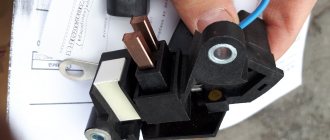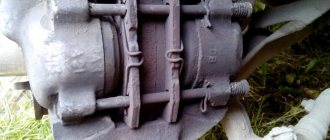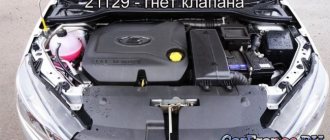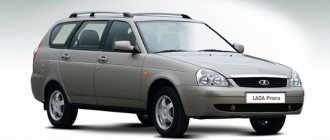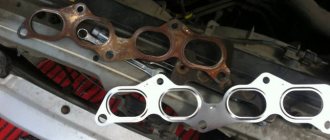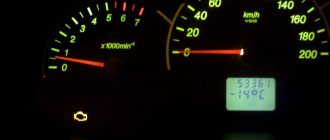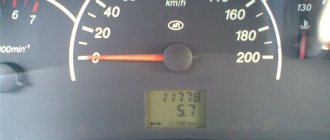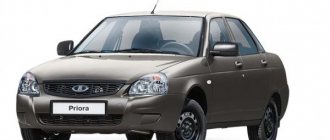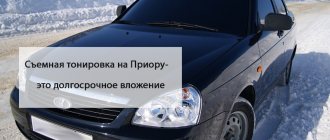→ Electrical circuits and ECU
Firstly, Federal Mogul is a German company, not a pendosiya. Now about the timing belt. The fact that he is torn is nonsense. The belt really reaches its lifespan of 200 thousand. km. But bent valves and connecting rods are not uncommon. The reason is the misalignment of the belt and the support roller bearing axis. Because of this, the single-row radial bearing operates misaligned. Since it is located in the leading branch of the belt, the loads on it are high. The bearing cage is destroyed, the belt slips and the shafts become desynchronized. The reason for the misalignment of the belt and bearing axis is either non-parallelism of the axes of the shafts, pumps, rollers, taper of the pulleys or rollers, or wear of the spacer washer 21126-1005317-00 or the crankshaft toothed pulley 21126-1005030-00, or the belt itself is crooked. Because of these jambs, the belt constantly tries to move. It is kept from moving by a washer and a crankshaft pulley. If the above jambs are minor, then the washer and pulley effectively center the belt. Otherwise they do it, but not for long. That is, by assessing the wear rate of these parts, one can judge the quality of the assembly and the service life of the timing drive as a whole. If the drive has worked for 100 thousand. km, there is no noticeable wear - the unit is quite reliable. If there is noticeable wear after 45 thousand, you need to look for and eliminate the cause of the belt slipping, and not wait for the roller bearing to fail. The belt alignment on motors 2112 and 21124 is done slightly differently - due to flanges on the support roller and tension roller. This increases wear on the side surfaces of the belt, which does not add service life to the belt and therefore to the drive. In addition, the size of the pulleys increases as the motor heats up, and the tension mechanism is rigid (without a damper). As a result, in order not to bend the shafts of the mechanisms, the damper is the belt itself - it is more “rubber” than Prior’s. That is, on a cold engine, when the pulleys are “small”, the belt is compressed to eliminate slippage. When the pulleys are hot, the belt stretches. It also stretches with a sharp change in engine speed, especially when cold. Constant cycles of tension and compression lead to accelerated aging of rubber. Which again does not add resource. As for the pistons. Maybe they don’t bend the valves, maybe they provide the same volume of the combustion chamber. But the engine efficiency (and therefore power and consumption) will be worse than with FM pistons. Because: 1 The area of the piston on the side of the combustion chamber is larger, that is, there is more heat flow to the piston and less gas expansion work. A hotter piston transfers more heat through the rings, which also reduces their life. 2 A flatter piston surface on the combustion chamber side provides better ventilation of the cylinder. Here the pistons with grooves and displacer are again in flight. 3 The uneven surface of the piston causes strong turbulence during the compression stroke, which in turn violates the clear boundaries of the flame front during the power stroke. That is, ignition of the mixture takes longer, so the mixture during combustion does not do the full work as with a flat piston, and the hotter one is thrown out of the cylinder. 4 Overheating of the piston can easily provoke spontaneous ignition of the mixture, which will also not add power. Conclusion: you can ride them, but in pensioner style. If you try to extract the maximum from them, like from your relatives, then you will be disappointed - the former agility will no longer be there, and fuel consumption, on the contrary, will jump. And finally. To prevent the engine from knocking, there is no need to experiment with oil and gasoline; in 90% of cases this is the reason, and only 10% is in the hardware.
The problem of timing belt breakage and valve damage is familiar to many owners of the new Priora with a lightweight connecting rod and piston mechanism.
The problem can be avoided by timely diagnosing the condition of the belt and replacing it if necessary. But even responsible owners of domestic transport note that problematic situations, even with a thorough study of internal systems, do not completely disappear.
Therefore, the right solution would be plugless pistons for the Priora, the installation of which can be done in the salon or by the motorist himself.
High-quality plug-in pistons for Priora: product features and advice from owners
The main advantage of the spare parts is the presence of deep recesses for the valves, which in the event of a timing belt break do not allow engine elements to fail. Thus, possible breakdown and the need for repairs are completely prevented.
High-quality Priora plug-inless pistons help not only to avoid problems with the car, but also to spend a large amount of money on subsequent restoration. The valve problem will be solved forever.
Among the most popular products, motorists note Kostroma pistons for Priora, which are plugless and have an affordable price. With them you can secure your car quickly and inexpensively. Therefore, most Lada owners with an 8-valve engine liked the purchase for its practicality. The installed elements do not affect changes in the operation of the unit in any way.
Less popular are plugless pistons on the Priora STK, which are more expensive. True, the current owners have no complaints about wear resistance or any other qualities of the products. This manufacturer is also recommended by many auto repair shops. Therefore, when choosing, it is important to take into account the opinions of both specialists and experienced drivers.
An additional nuance when choosing suitable products should be the dimensional differences and the kit itself. You can buy plugless pistons for Priora with a nominal diameter of 82 mm or repair models with a larger size.
There are also certain classes that differ in the gap parameters. It is also worth considering the presence of additions: for installation, you can use old connecting rods and stoppers only if they are not damaged.
How to replace Priora pistons with plug-in ones with your own hands?
Correct and high-quality replacement of pistons on a Priora with plug-in ones should begin with the complete removal of oil and disassembly of the timing belt. The replacement procedure is quite complex and requires careful consideration of each stage.
If installed incorrectly, engine malfunctions or even unit breakdown may occur. If the owner is not confident in his abilities, then he should contact a repair shop. If the driver is experienced and is not the first time doing repairs, then you need to start performing the following tasks:
1. The cylinder head is removed and the connecting rods are disconnected.
2. The connecting rod and piston mechanism is removed.
3. Old pistons are removed and new pistons are installed.
4. The piston rings and connecting rod bearings are being replaced.
5. A new gasket is installed on the cylinder head.
6. The block is assembled, new oil is poured in and run-in is performed.
You should also not forget about lubricating the rubbing parts to avoid problems when idling the engine. If installed correctly, new plug-in pistons on Priora will last for many years without any problems. But the owner should not forget to check the condition of the timing belt.
Despite the increased safety of the connecting rod and piston mechanism, other important parts of the car should not be left without attention.
Owners of Lada Priora cars often find themselves in unpleasant situations. A broken timing belt leads to dire consequences. The thing is that the pistons that the manufacturer installs at the factory when assembling the engine have recesses of insufficient depth. Motorists call these selections counters. This is the cause of destruction. Repairing the engine after such an incident will be expensive for the car owner. It is cheaper to replace the standard ones with the so-called plugless pistons on the Priora.
How to replace pistons
This is a fairly serious operation that fits into the category of a major overhaul. It requires the application of both skill and simply physical strength. In addition, there is a fairly large volume of tools and devices. What a repairman will need:
- Replacement pistons set with rings.
- Pins and stops.
- Crankshaft oil seals.
- Complete locksmith set of keys.
- Retaining ring removers.
- Hammer and punch.
- Engine oil.
- Containers for oil and antifreeze.
- Clean rags.
Some aspects will be mentioned briefly as they are described in separate articles. So.
The work is best done on a stationary lift. As a last resort, in a well-equipped inspection pit.
Using containers, drain the antifreeze and oil from the crankcase. These details are described in some detail in separate articles. As well as removing the gearbox. Which is the next step. After removing the box, it’s time to work on the motor.
The generator belt is released and unscrewed using the 17 head for the damper mounting bolt. When removing the damper, it must be checked to see if it needs to be replaced. Remove the cover and, in sequence, the timing belt and crankshaft gear. Now remove all the bolts holding the oil pan. Remove the oil intake. Now access to the crankshaft is completely open. Using a wrench, unscrew the 10 bolts securing the journals of the 5 main bearings and set them aside.
Special attention! The inserts must be folded in the order in which they were installed. It is best to mark them with a marker so as not to accidentally replace each other, and then install them in the reverse order.
Everyone in their place. Otherwise, you can get premature wear on the crankshaft surface, which will lead to its replacement.
Once the fasteners are removed, you can finally remove the crankshaft assembly with pistons and connecting rods for replacement. Transfer it to a clean surface and wipe with a rag. Using a puller, pull out the retaining rings of the piston pins, then carefully, using a drift, knock out the pins and remove the pistons.
Replace all pistons in the group. Install new pistons in place according to the marks. Insert fingers and secure with rings
Reassemble everything in reverse order, paying special attention to the order in which the neck liners are installed. Reinstalling the timing belt is a very important operation, and there is a separate article on its implementation.
Replace the crankshaft oil seals. Add oil and antifreeze and you can try starting it.
Replacing Priora pistons during tuning
There are no special features here, except for the uniqueness of the pistons themselves. They usually have a shorter skirt and slight design differences. They all boil down to increasing engine power. But most importantly, they must have grooves for the valves. This is an indispensable condition when choosing a replacement. Sometimes they are called "turbo pistons". But this is already a specialization of young “racing drivers” and mechanics serving this category.
Video on replacing Priora pistons:
Source
Physics of pistons, loads
This element is designed to convert energy from a fuel explosion into translational motion and transfer it to the crankshaft. When gases expand after an explosion, mechanical and temperature effects are exerted on the piston and its working surface. The part experiences high-intensity loads. The maximum possible pressure in the Priora engine can reach up to 65-80 bar. This is practically several tons. During operation, the pistons can periodically accelerate their movements to 100 km/h or more. Also, their movement can slow down to almost zero at a frequency of up to 200 Hz at 6000 rpm. When a mixture of fuel and air explodes in a cylinder, the temperature inside can reach 1800-2600 degrees. Under such temperature influences, the strength characteristics are reduced. Thermal stresses arise due to sudden temperature changes. It is also worth adding stress from the pressure of combustion products and inertia during acceleration and deceleration at high frequencies.
About the design of standard pistons
In order to work in such conditions, the part must be as light as possible. And the material is wear-resistant. The alloy must also have high thermal conductivity. This will ensure a high cooling rate. External working surfaces must be made in such a way that the part does not jam in the heated cylinder. Also, combustion products should not penetrate the crankcase. The piston is barrel-shaped; there is a big difference between the degree of heating of its working part and the skirt. This allows all requirements to be met.
To compensate for possible deformations of the skirt during operation, the piston is manufactured with a “counter-ellipse”. The major axis of the part is strictly perpendicular to the axis of the hole for installing the pin.
The piston head or its upper part includes the bottom. There are also special grooves for mounting o-rings. To ensure that the upper part can cope with high loads, it is covered with a special layer of protective coating at the production stage. The grooves for installing the rings are made so that there is a slight angle. This ensures that the outer edge of the ring is located higher than the inner one. This prevents the cross-section of the groove from tilting downwards during operation at high temperature loads. To ensure better sliding, the piston is treated with special coatings over the entire working surface. In order for the part to run in better, coatings are applied that will wear out during the running-in process. This is tin coating or phosphating. Materials that improve slip remain on the surface throughout the entire service life.
The skirt is processed using cutters. This is done to obtain a microrelief. Due to this, the oil is better retained on the surface of the part, thereby reducing friction.
| PISTON | 21126-1004015 |
| Manufacturer | Federal-Mogul Powertrain East LLC. Tolyatti. (Federal Mogul) |
| Piston diameter (nominal), mm: | 82 |
| Piston height, mm: | 45,4 |
| Compression height, mm: | 25,4 |
| Heat zone, mm: | 4,0 |
| Height of the groove for the 1st compression ring, mm: | 1,25 — 1,23 |
| Height of the groove for the 2nd compression ring, mm: | 1,54 — 1,52 |
| Height of the groove for the oil scraper ring, mm: | 2,03 — 2,01 |
| Pin hole offset, mm: | 0,5 |
| Recommended clearance in the cylinder, mm: | 0,040 ±0,012 |
| Piston crown surface: | flat |
| Recess depth for inlet valve, mm: | 1,70 |
| Recess depth for outlet valve, mm: | 1,49 |
| Total volume of samples in the piston, cm 3: | 0,125 ± 0,015 |
| The distance at which the actual diameter of the piston is determined, (from the lower edge of the piston), mm: | 10 |
| Coverage/microprofile: | microprofile |
| Weight, g: | 244 |
| Piston pin | 21126-1004020 |
| Piston pin diameter, mm: | 18 |
| Piston pin length, mm: | 53 |
| Piston rings | |
| Ring height, mm: | 1,2/1,5/2 |
| Retaining rings | 11194-1004022 |
| Note | |
| The piston arrives for assembly and for sale as part of a kit - piston, rings, pin, connecting rod, retaining rings. | |
| Set weight (piston+pin+connecting rod+circlips+piston rings), g: | 796 |
*—parameters and dimensions of products from other manufacturers may differ from those indicated.
Design features.
For the VAZ 21126 engine, a new design of the connecting rod and piston group was developed. Specialists from the company Nural (Nural), part of the Federal Mogul corporation, took part in the development of the piston engine. For the first time for a VAZ engine, a new T-shaped piston design was chosen. The bottom shape is flat with 4 small recesses.
Due to the use of “thin” piston rings, it was possible to reduce the height of the sealing and fire belt. The use of oil nozzles in the engine to supply oil to the inner surface of the piston ensured a significant reduction in the thermal load on this part. The piston uses a shortened piston pin of the “floating” type, secured with retaining rings and with a diameter of 18 mm. This made it possible, in the piston design, to remove a significant amount of metal in the area of the bosses, thereby increasing the size of the “refrigerator” and reducing the guide sections of the piston skirt. Excess oil is drained into the “refrigerator” area through holes made in the groove for the oil scraper ring. Piston 21126 is manufactured by stamping (forging) and does not have temperature-compensating elements. Reducing the weight of the connecting rod and piston group had a positive effect on improving the dynamic characteristics of the engine.
Basic markings applied to the bottom of the part.
1. Orientation marker - “ ” when installed, should indicate the direction towards the camshaft drive
2. Class marker - one of the symbols (“A”, “B”, “C”) determines the deviation in the outer diameter.
3. Marker model “21126”
4. Model marker, according to the manufacturer's classification.
Main Dimensions
| Piston class by outer diameter | A | B | C |
| Piston diameter 82.0 (mm) | 81,965-81,975 | 81,985-81,995 | 82,005-82,015 |
The precision manufacturing of the hole for the piston pin ensures a gap of 0.001-0.002 mm and allows the use of a pin of the same size (17.990-17.995 mm).
A number of third-party manufacturers sell pistons in repair sizes - 82.5 mm and 83.0 mm.
Applicability of piston 21126-1004015.
| Engine | Cylinder block, block height, mm. | Knee. shaft crank radius, mm. | connecting rod, connecting rod length, mm. | Piston, compression height, mm | Non-income piston in block, mm |
| VAZ 21126 | 21126-1002011 197,1 | 11183-1005016 37,8 | 11194-1004045 133,32 | 21126-1004015 25,4 | 0,58 |
* - calculated dimensions may differ from actual ones within the manufacturing tolerances of the specified parts.
Differences in the design of “safe” pistons for Priora
So, the plugless pistons on the Priora are practically no different from the standard ones. This is actually an exact copy of a standard piston for AvtoVAZ engines.
But there is no traditional mirror on the top - instead there are deep recesses. This allows you to protect both the timing parts and the pistons themselves when meeting the valves. Dimensions and all other parameters fully correspond to the characteristics of standard parts.
List of car models in which it was installed
For the first time, the VAZ 21126 engine appeared on the Lada Priora sedan 2170 and hatchback 2172 in 2007 - 2008. Later the Priora station wagon and coupe came out. After running in the VAZ 21126 engine on Priora, it was installed on Kalina, Samara and Grants.
Similar article Setting timing marks for Priora engine 16 valves VAZ 21126
| Models of cars with VAZ 21126 engine | Body | Years of manufacture |
| Kalina | Sedan 1118 | 2008 — 2014 |
| Sports 1119 | 2009 — 2013 | |
| Station wagon 1117 | ||
| Hatchback 1119 | ||
| Kalina 2 | Hatchback 2192 | 2013 — 2018 |
| Station wagon 2194 | ||
| Sports 2192 | 2014 — 2018 | |
| NFR 2192 | 2016 — 2017 | |
| Samara 2 | Hatchback 2114 | 2009 — 2013 |
| Coupe 2113 | 2010 — 2013 | |
| Granta | Sedan 2190 | Since 2011 |
| Liftback 2191 | Since 2014 | |
| Station wagon 2194 | Since 2018 | |
| Hatchback 2192 |
The VAZ 21126 engine is mainly used in cars equipped with a Jatco JF414 automatic transmission.
Why install non-factory pistons?
This is different for each car. If you fully comply with the manufacturer's regulations for engine maintenance, install recommended or at least high-quality spare parts and consumables, then the car will serve for a long time and properly, and all mechanisms and components will operate in their normal modes.
But everyone wants to save money or have their car tuned, and here a number of questions arise. If you save at the expense of the timing belt (and this is the belt and rollers for it), buying obviously low-quality parts, then you should take into account that their replacement intervals will drop as well as the price. For example, if as a standard on AvtoVAZ engines the belt should be changed after 30-50 thousand km, then rarely anyone managed to drive more than 5-10 thousand km with cheap and non-original components.
Some tuning specialists try to take everything and even more from the engine than it can give. Motors are often equipped with compressors. However, most of the parts and components in the engine are not at all designed for such loads. The engine cannot operate for a long time in the range of 7-9 thousand revolutions. The timing mechanism is not designed for such use either - the weakest link is always damaged. And this is the belt. And what to do when you want to save money and still not drive slowly? You can get out of this situation by installing plugless pistons on the Priora.
Flaws
In the process of creating various AvtoVAZ engines for front-wheel drive models, designers and engineers initially created similar pistons. Priora already had plug-free grooves from the factory (in early versions). More often they can be found on VAZ engines of the tenth family. This was due to the use of a belt instead of a chain. If you lighten the piston as much as possible, the engine gains an additional 5-7 percent of power, which is a lot. Replacing the pistons on the Priora with plugless ones will not increase power. This will only protect you from expensive repairs. To make a groove, the surface must be thick enough. The piston is made heavy, which takes away power. The groove also has an unsatisfactory effect on the compression of the combustible mixture. This also affects power. As a result, if you install such parts on a car, the engine loses 5-7% of its power. For a 150 hp engine. With. this is 10.5 l. s, which is very significant.
This is what those who have already installed plugless pistons on their Priora car write. Reviews show that, in addition to a decrease in power, fuel consumption has increased. Detonation increases due to uneven weight distribution.
Types of coating
In total, there are 2 main types of coverage. These are molecular and ceramic.
In the first case, the binding of the composition to the surface occurs at the molecular level. In many ways this is reminiscent of metallization. The main advantage is the ability to mechanically reflect heat. Molecules at high temperatures are repelled from the protective coating and hardly heat it up.
Ceramic coating has gained popularity due to its excellent insulating properties. The material is able to absorb heat, making it the top layer.
It is the upper layers of the pistons that act as the main protective measures. They retain heat and do not allow it to penetrate deeper into the structure of the material. Ceramic treatment helps to increase efficiency, that is, the power of the internal combustion engine increases. Research has clearly shown that the increase in power can be 4-8%.
Modern heat-resistant coatings are successfully implemented on various engines. These are mainly forced engines, power units of racing cars and race cars.
Now it’s worth taking a separate look at the coatings used in automobile engines to protect and increase the life of pistons.
STI, Tolyatti
These products are manufactured in Tolyatti using hot pressing technology. Judging by the reviews of those who have already equipped the engine with them, the parts significantly reduce the efficiency and power of the engine. This can be explained by the low compression ratio and large cylinder size. Valve recesses are too deep.
The low silicon content in the alloy does not have the best effect on the strength characteristics. A lower nickel content reduces the resource. At the same time, they have a high cost from STI.
